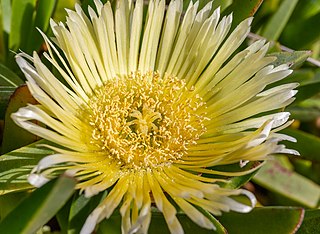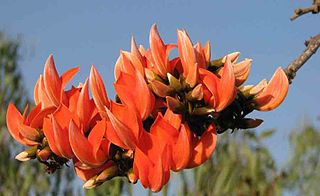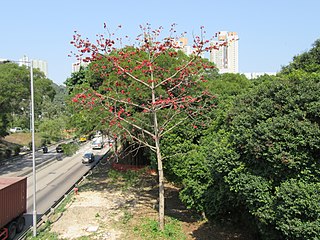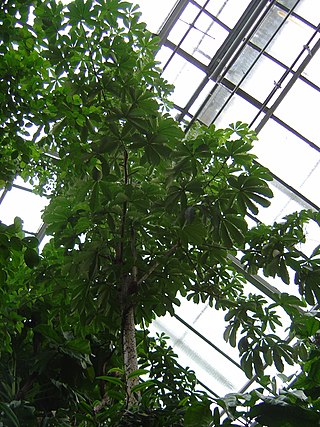
Cercis canadensis, the eastern redbud, is a large deciduous shrub or small tree, native to eastern North America from southern Michigan south to central Mexico, east to New Mexico. Species thrive as far west as California and as far north as southern Ontario, roughly corresponding to USDA hardiness zone 5b. It is the state tree of Oklahoma.

Carpobrotus edulis is a ground-creeping plant with succulent leaves in the genus Carpobrotus, native to South Africa. Its common names include hottentot-fig, sour fig, ice plant or highway ice plant.

Hibiscus rosa-sinensis, known colloquially as Chinese hibiscus, China rose, Hawaiian hibiscus, rose mallow and shoeblack plant, is a species of tropical hibiscus, a flowering plant in the Hibisceae tribe of the family Malvaceae. It is widely cultivated as an ornamental plant in the tropics and subtropics, but its native range is Vanuatu.

Syzygium samarangense is a species of flowering plant in the family Myrtaceae, native to an area that includes the Greater Sunda Islands, Malay Peninsula, and the Andaman and Nicobar Islands, but introduced in prehistoric times to a wider area and now widely cultivated in the tropics. Common names in English include wax apple, Java apple, Semarang rose-apple, and wax jambu.

Paulownia is a genus of seven to 17 species of hardwood tree in the family Paulowniaceae, the order Lamiales. They are present in much of China, south to northern Laos and Vietnam and are long cultivated elsewhere in eastern Asia, notably in Japan and Korea.

Lawsonia inermis, also known as hina, the henna tree, the mignonette tree, and the Egyptian privet, is a flowering plant and one of the only two species of the genus Lawsonia, with the other being Lawsonia odorata. The species is named after the Scottish physician Isaac Lawson, a good friend of Linnaeus.

Acer circinatum, the vine maple, is a species of maple native to western North America.

Heptapleurum arboricola is a flowering plant in the family Araliaceae, native to Taiwan and Hainan Province, China. Its common name is dwarf umbrella tree, as it resembles a smaller version of the umbrella tree, Heptapleurum actinophyllum.

Butea monosperma is a species of Butea native to tropical and sub-tropical parts of the South Asia and Southeast Asia, ranging across Bangladesh, India, Nepal, Pakistan, Sri Lanka, Myanmar, Thailand, Laos, Cambodia, Vietnam, Malaysia, and western Indonesia. Common names include flame-of-the-forest, dhak, palash, and bastard teak. Revered as sacred by Hindus, it's prized for producing an abundance of vivid blooms, but it's also cultivated elsewhere as an ornamental. Butea monosperma, which grows slowly, creates a stunning specimen tree.

Peranakan cuisine or Nyonya cuisine comes from the Peranakans, descendants of early Chinese migrants who settled in Penang, Malacca, Singapore and Indonesia, inter-marrying with local Malays. In Baba Malay, a female Peranakan is known as a nonya, and a male Peranakan is known as a baba. The cuisine combines Chinese, Malay, Javanese, South Indian, and other influences.

Bombax ceiba, like other trees of the genus Bombax, is commonly known as cotton tree. More specifically, it is sometimes known as Malabar silk-cotton tree; red silk-cotton; red cotton tree; or ambiguously as silk-cotton or kapok, both of which may also refer to Ceiba pentandra.

Bombax buonopozense, commonly known as the Gold Coast bombax or red-flowered silk cotton tree, is a tree in the mallow family. It is also known in the Dagbani language as Vabga.

Memecylon is a plant group in Melastomataceae. It consists of 350-400 species of small to medium-sized trees and shrubs occurring in the Old World tropics. Memecylon is a monophyletic group basal to the Melastomataceae clade. Memecylon taxa have more than 600 published basionyms. Diversity of this group is concentrated in tropical Africa, Madagascar, Sri Lanka, India and Malaysia.

Memecylon umbellatum, commonly known as ironwood, anjani (Marathi) or alli (Telugu), is a small tree found in India, the Andaman islands and the coastal region of the Deccan. It is also found in Sri Lanka, where it is called blue mist, kora-kaha and kurrikaya. The leaves contain a yellow dye, a glucoside, which is used for dyeing the robes of Buddhist monks and for colouring reed mats. Medicinally, the leaves are said to have anti-diarrhoeal properties. Historically, this plant was burnt as fuel in the production of Wootz steel.

Koelreuteria bipinnata, also known as Chinese flame tree, Chinese golden rain tree, Bougainvillea golden-rain tree, is a species of Koelreuteria native to southern China. It is a small to medium-sized deciduous tree growing between 7–20 metres tall. It is few branched and is one of the few trees that bloom in summer. The tree can live 50 to 150 years.

Bruguiera sexangula, commonly called the upriver orange mangrove, is a mangrove shrub or tree usually growing up to 15 m, occasionally 30 m, in height.

Carpodetus serratus is an evergreen tree with small ovate or round, mottled leaves with a toothy margin, and young twigs grow zig-zag, and fragrant white flowers in 5 cm panicles and later black chewy berries. It is an endemic of New Zealand. Its most common name is putaputāwētā which means many wētā emerge - referring to the nocturnal Orthoptera that live in holes in the trunk of this tree made by Pūriri moth caterpillars. Regional variations on the name also refer to this insect that lives and feeds on it such as kaiwētā, and punawētā. The tree is also sometimes called marbleleaf. It is found in broadleaf forest in both North, South and Stewart Islands. It flowers between November and March, and fruits are ripe from January to February.

Ceriops tagal, commonly known as spurred mangrove or Indian mangrove, is a mangrove tree species in the family Rhizophoraceae. It is a protected tree in South Africa. The specific epithet tagal is a plant name from the Tagalog language.
Utania racemosa is a species of flowering plant in the family Gentianaceae. It occurs in Southeast Asia from Sumatera in Indonesia to the Andaman Islands in India. Its wood is used for timber and fuel.
Memecylon pauciflorum is a tree species in the Melastomataceae family. It grows as a tree or shrub in northern Australia and tropical and subtropical Asia. An understorey species typically, it grows in a variety of communities. The possum Petropseudes dahli uses this species as one of their scent-marking sites. It is a host to a number of funguses. People in Australia and in Thailand use the plant in folk medicine, though no efficacy has been demonstrated.



















